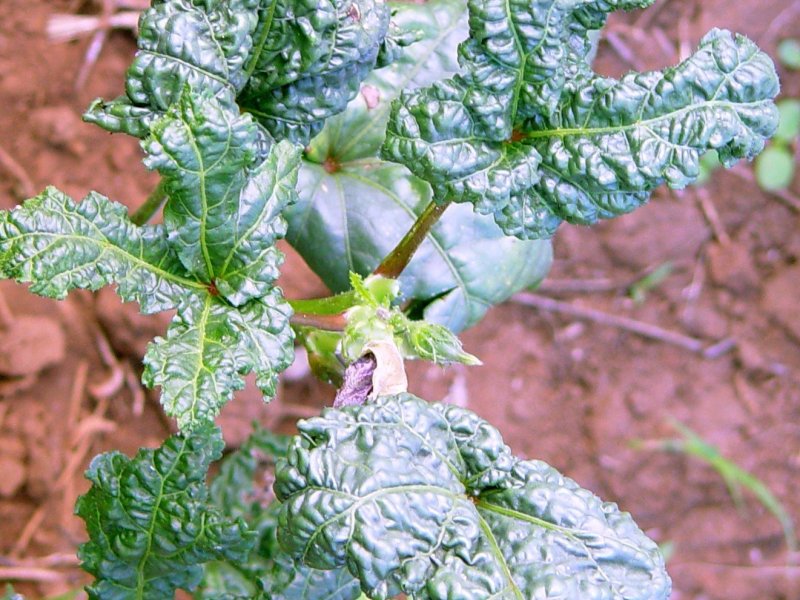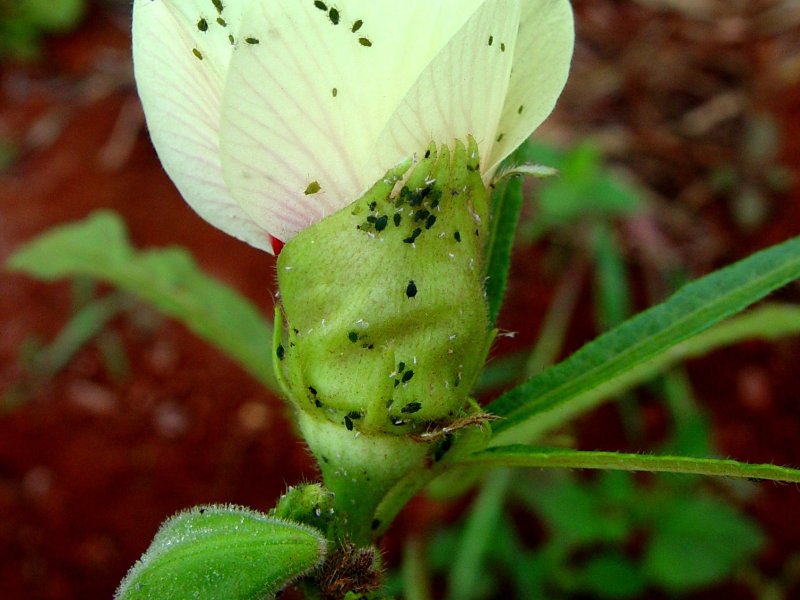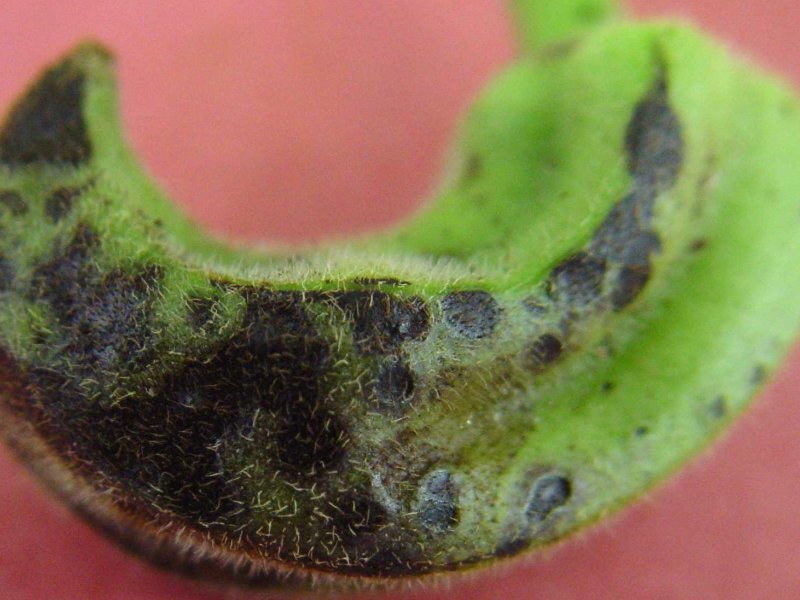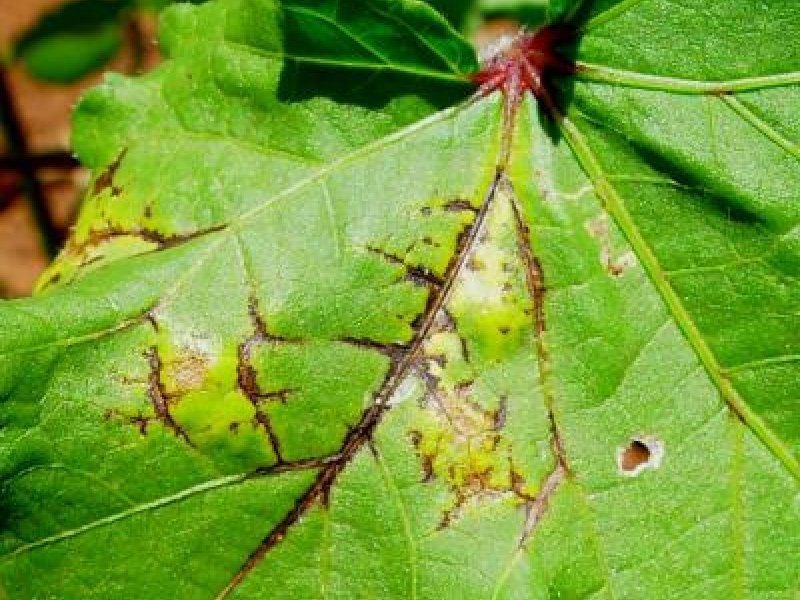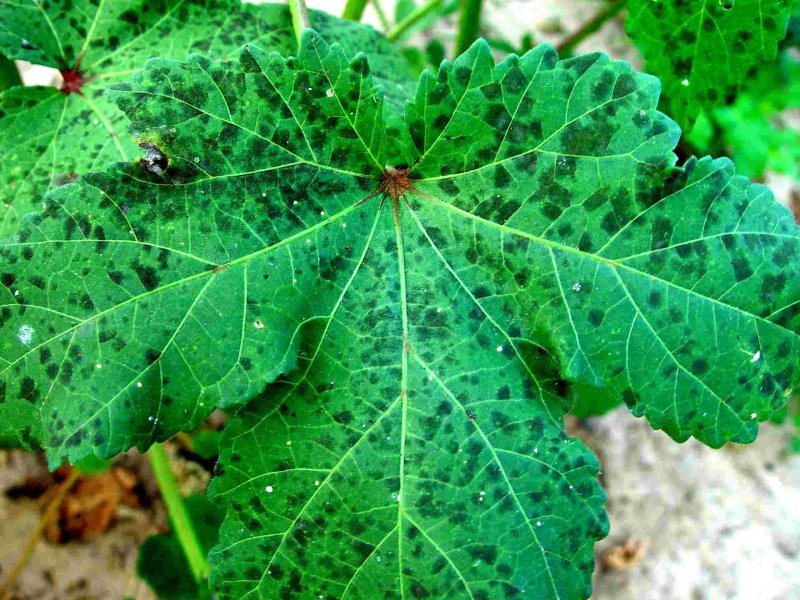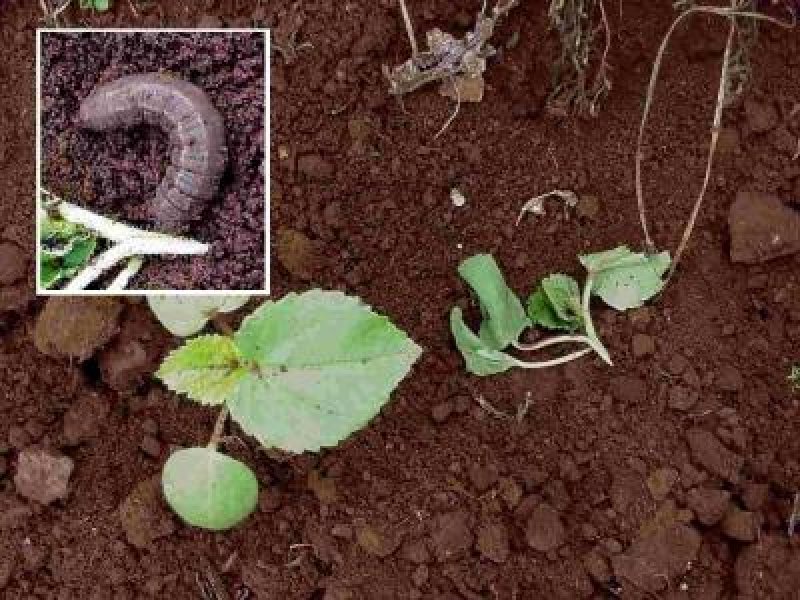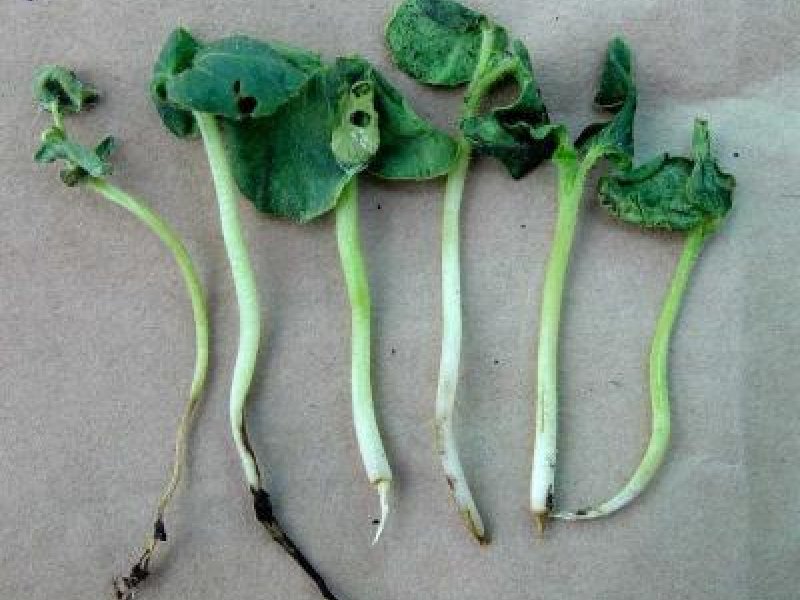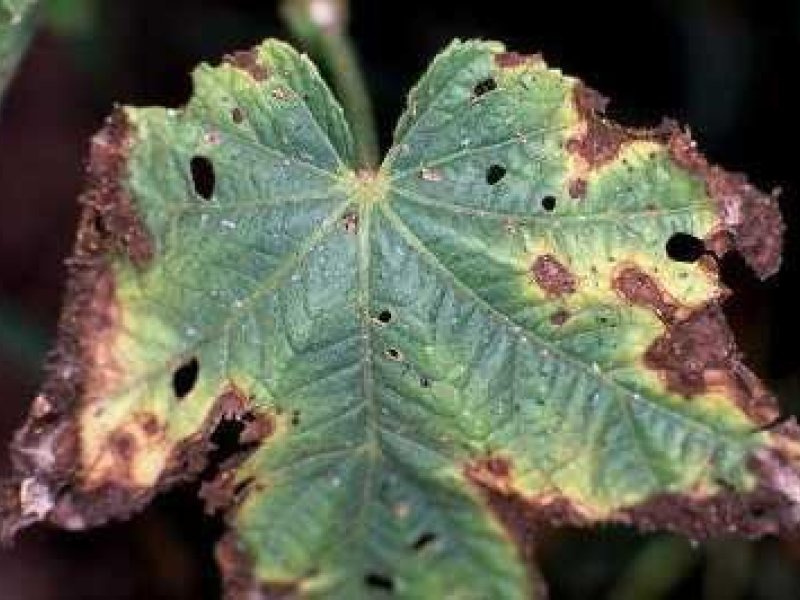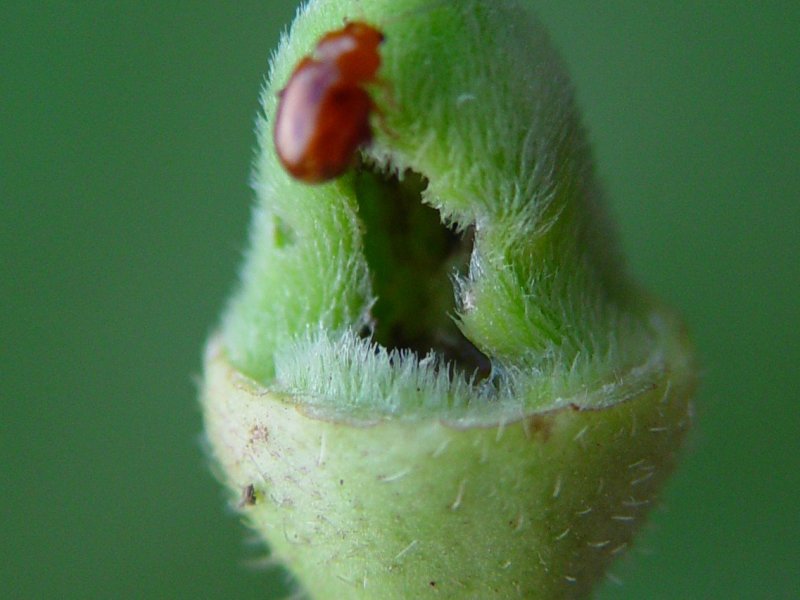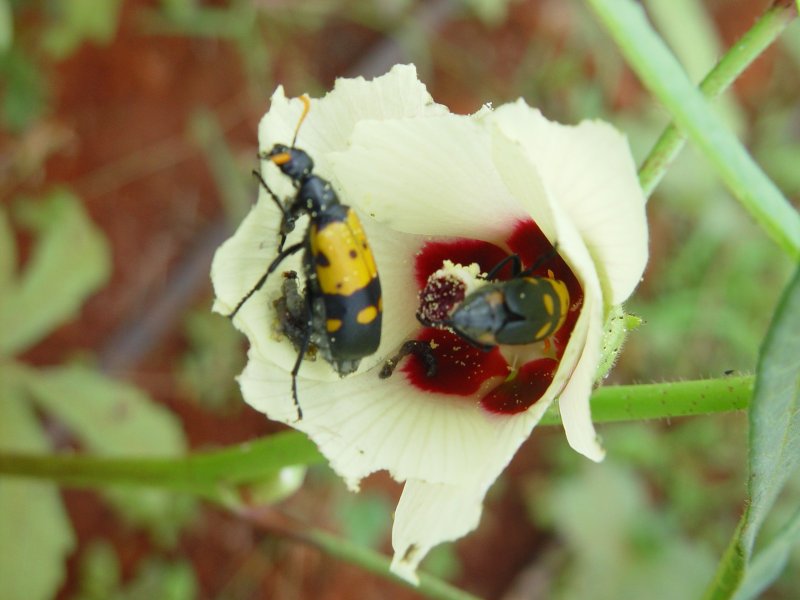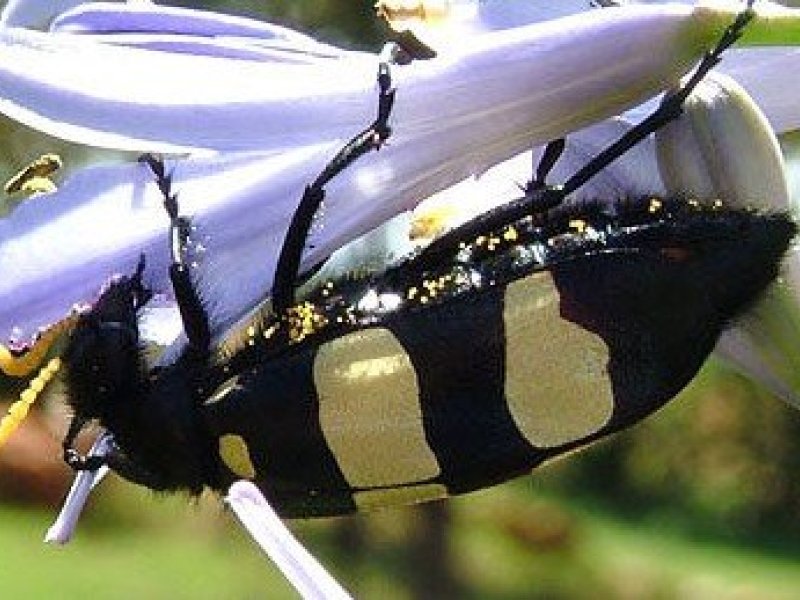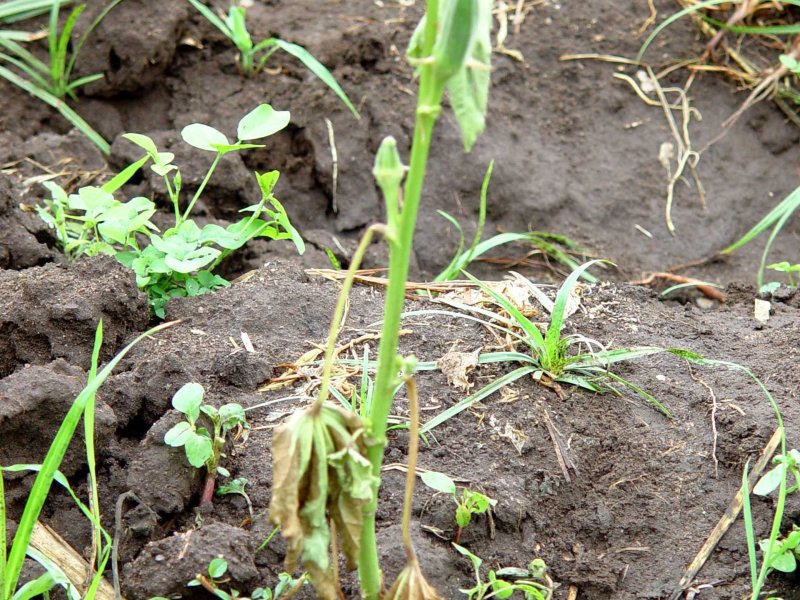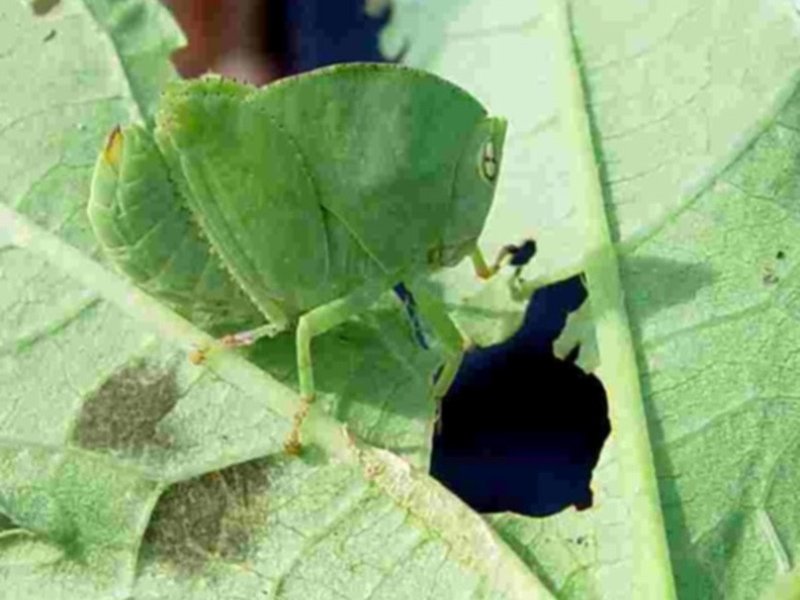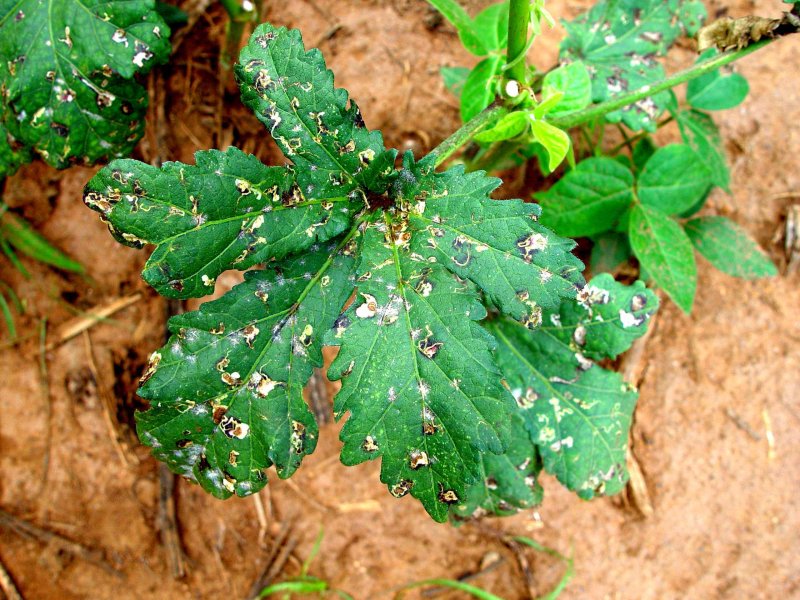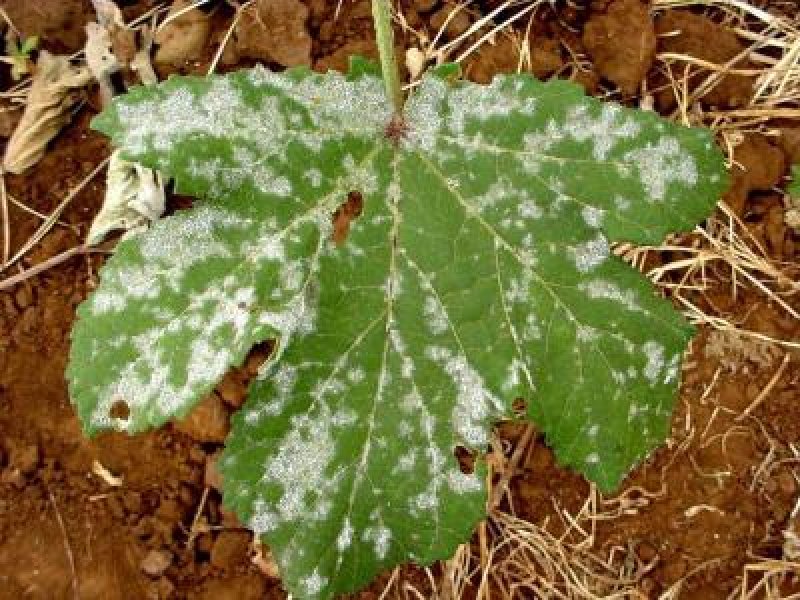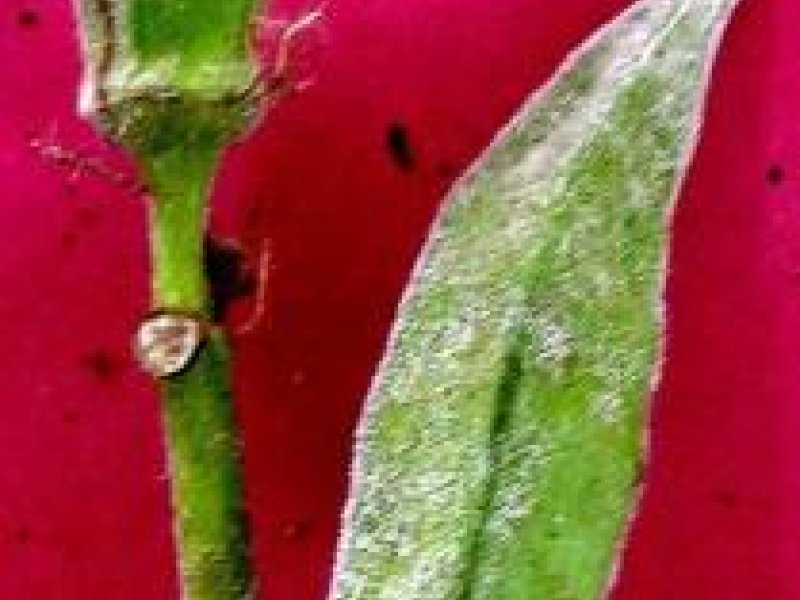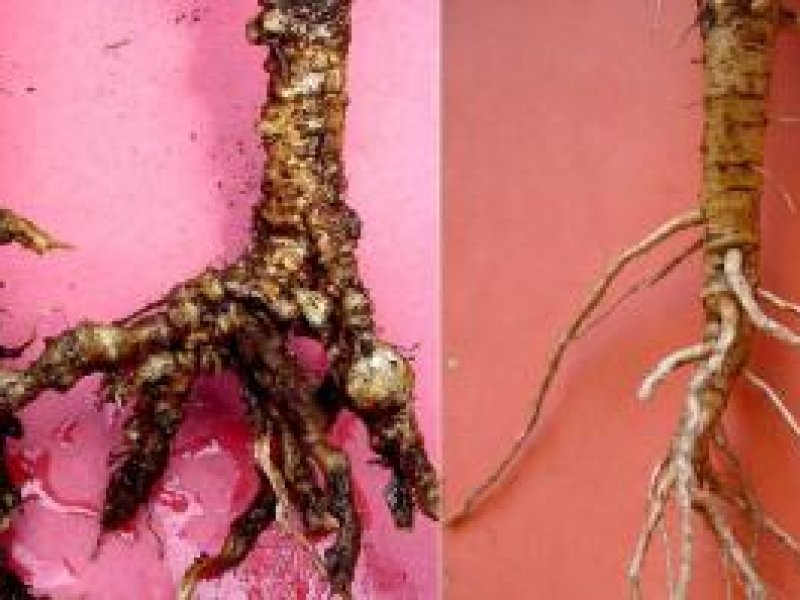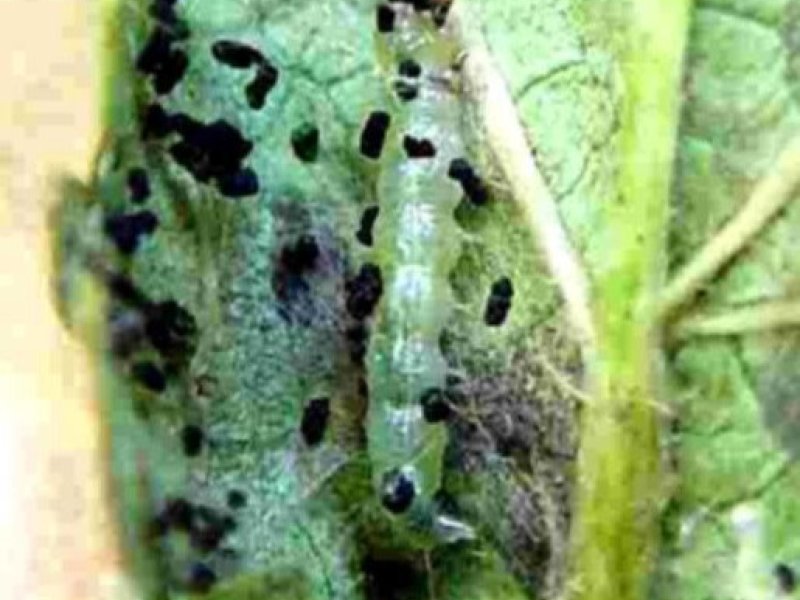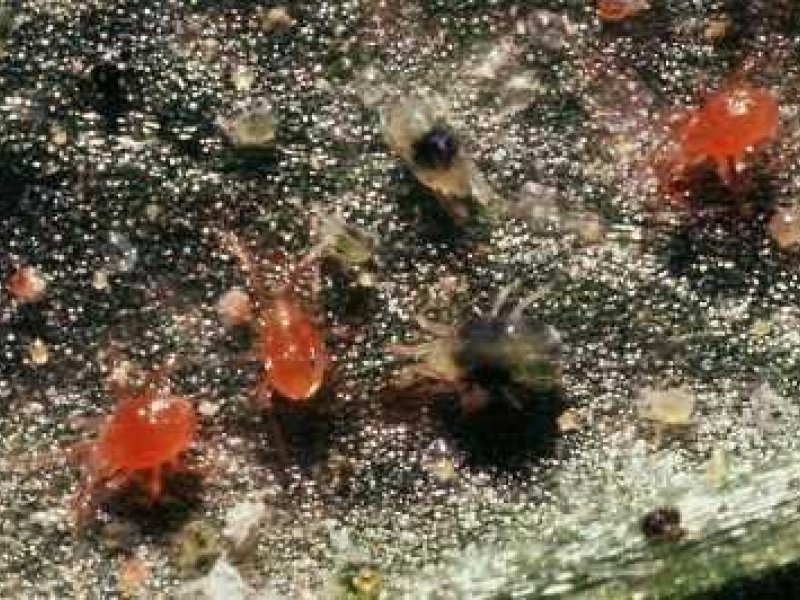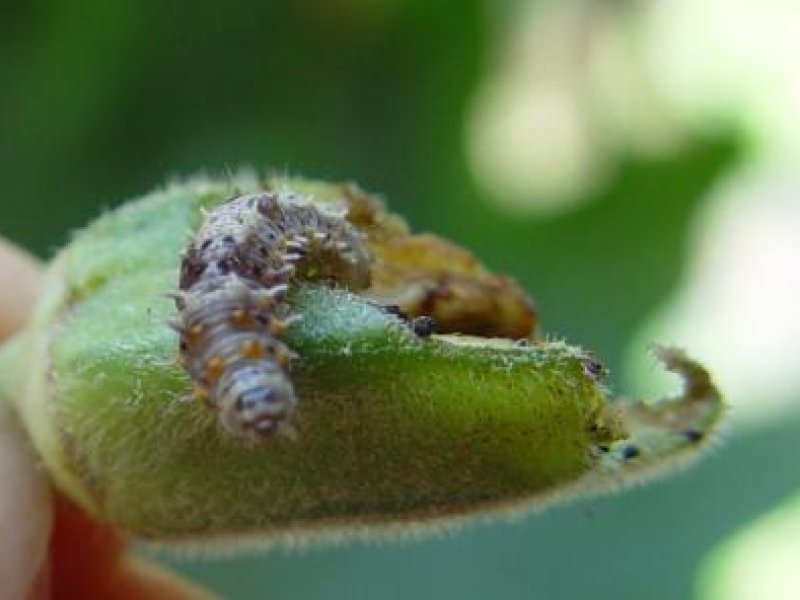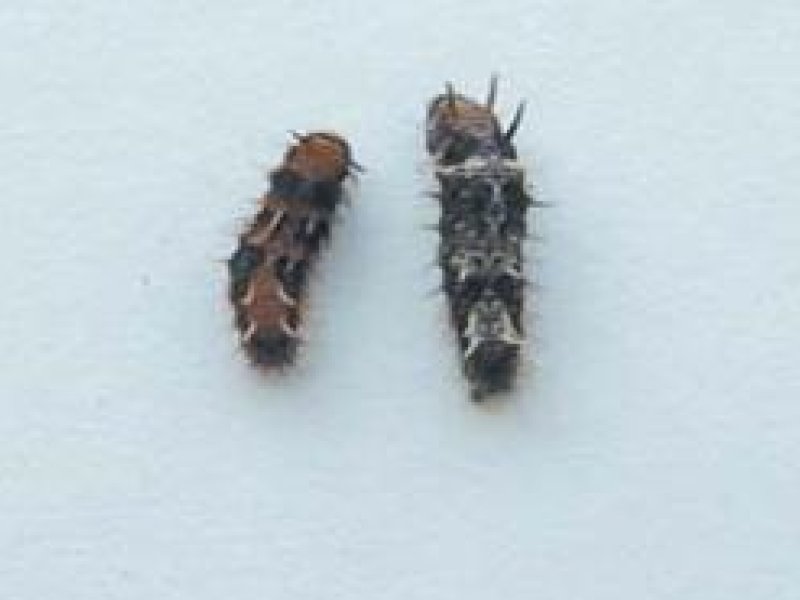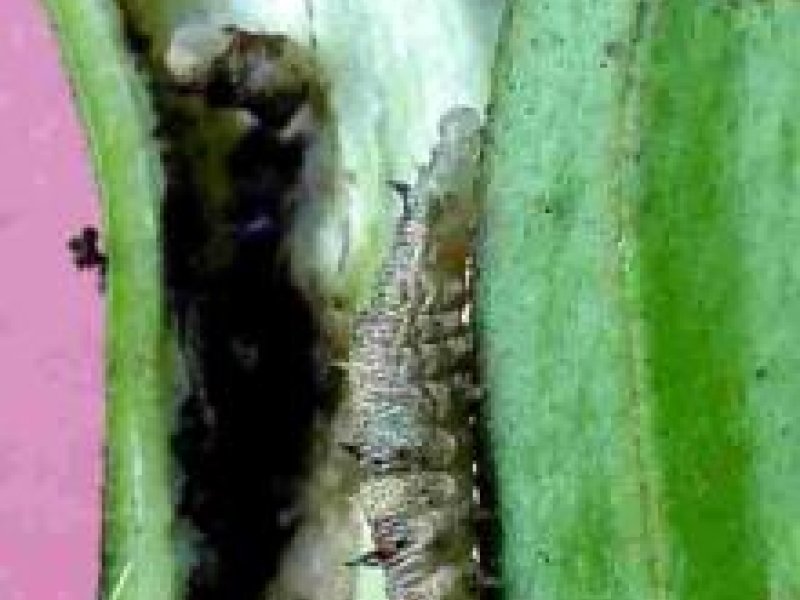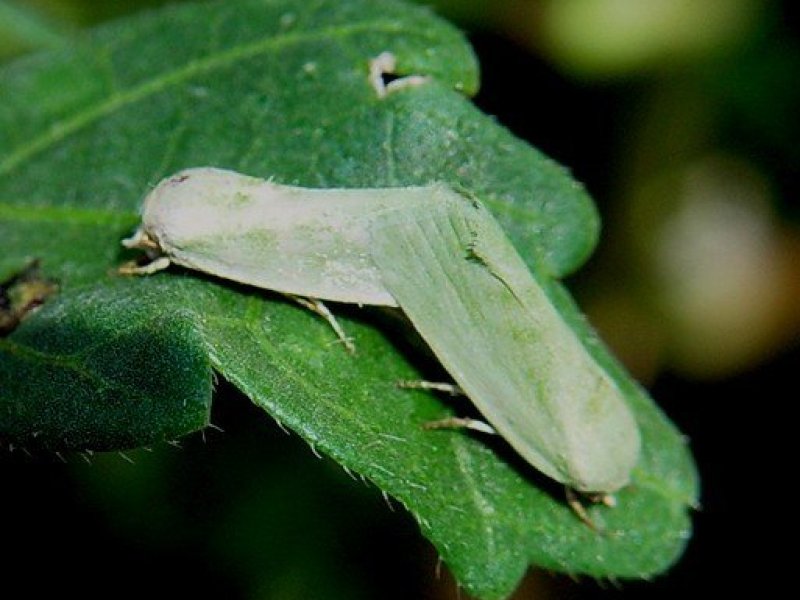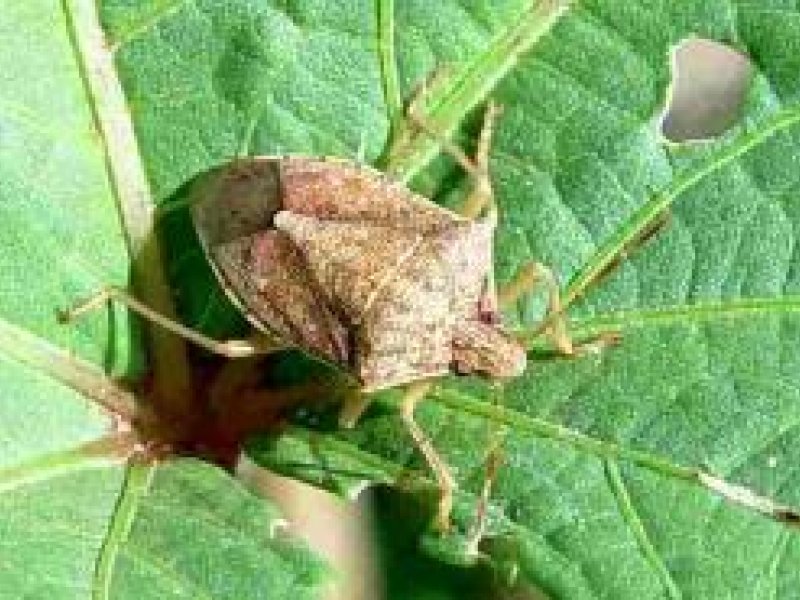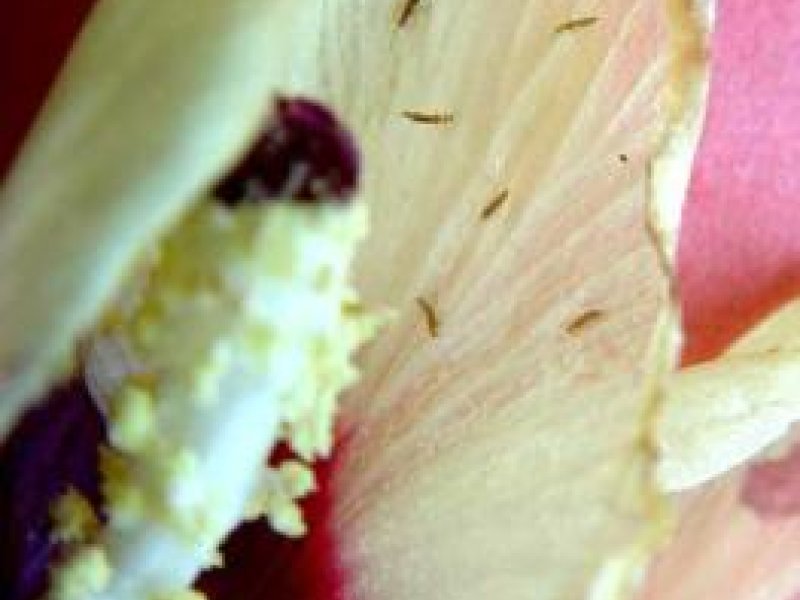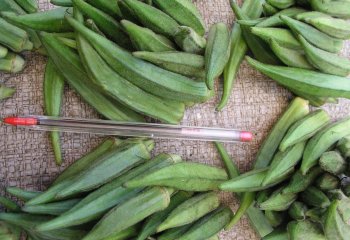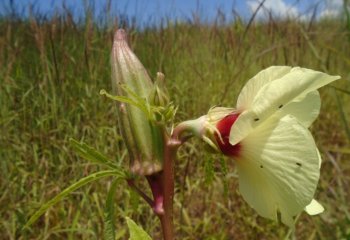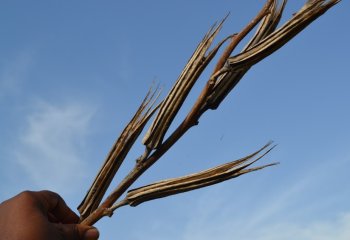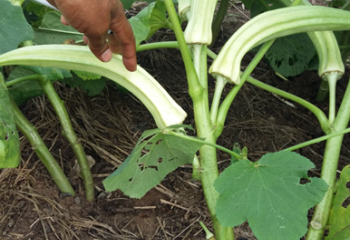|
African bollworm (Helicoverpa armigera) The African bollworm feeds on leaves, flowers and pods of okra. The main damage occurs on flowers and pods. Attack on flowers results in flower abortion. The caterpillar usually bore clean, circular holes in pods, causing extensive damage and promoting decay from secondary infection by diseases. |
|
|
What to do:
For more information on Neem click here. For information on Bt click here |
|
Cotton aphids (Aphis gossypii) The cotton aphid (Aphis gossypii), has been identified as one of the major pest problems of okra in Kenya. They cause damage by sucking plant sap weakening the plants, and by excreting a sticky substance (honeydew), which results in growth of sooty mould affecting photosynthesis. Contamination of pods with aphids, aphid skins, honeydew and/ or sooty mould may result in their rejection in the market. The cotton aphid transmits the Yellow Vein Mosaic Virus in okra. Cotton aphid (Aphis gossypii) is a small aphid. Adults range from just under 1-1.5 mm in body length. |
|
|
What to do:
|
|
Bacterial blight ( Xanthomonas campestris p.v. malvacearum) The bacterium is transmitted through seed and water splash. Symptoms consist of spots on leaves and pods. Leaf spots are initially soaked with water and are more obvious on the underside of leaves. They are restricted to the veins and are angular in shape. Spots on petioles are elongated, sometimes slightly sunken and blackish. Spots on pods are initially water-soaked and round. Later, they join together and turn oily black. All spots appear waxy and shiny.
|
|
|
What to do:
|
|
Black mould (Cercospora abelmoschi) Black mould can be serious in humid warm areas. It causes leaf spots of various shapes. It grows as a sooty to dark oily (olivaceous) mould on the underside of leaves, but when infection is severe and conditions are very humid it also appears on upper surface of infected leaves. Seriously infected foliage rolls, wilts and falls to the ground.
|
|
|
What to do:
For more information on Copper sprays click here. |
|
Cotton seed bugs (Oxycarenus spp.) They feed on developing pods. These bugs are small (4 to 6 mm), and blackish in colour. Their wings are transparent. They attack open or damaged pods mainly at the end of the growing season. Nymphs and adults suck from immature seeds, preventing them from ripening. Groups of bugs are usually found between flower buds, flowers and pods. These bugs are minor pests of okra and usually no control measures are needed.
|
|
|
What to do:
|
|
Bugs: Cotton stainers (Dysdercus spp.) Several species of bugs attack okra. Some of them occur from the early stages of the crop, but are more common during the mature stages, feeding on developing pods. Their feeding causes small, dark, raised blister-like spots on pods.
These bugs are very common on okra plants at the fruiting stage. They are conspicuously red with black bands. Both adults and nymphs feed on developing pods and seeds, piercing them to suck sap, thereby reducing yield. Attacked young fruits shrivel and then dry. Feeding on mature fruits results in damage to the seeds. Stainers also attack cotton and they live on baobab and silk cotton (kapok) trees.
Stainer bugs are between 14 and 24 mm long. |
|
|
What to do:
|
|
Cutworms (Agrotis spp.) Cutworms are the caterpillars of some moths. They destroy whole plants by girdling and cutting off young seedlings at the soil level during the night. They hide in the soil during the day.
|
|
|
What to do:
|
|
Damping-off diseases (Pythium spp., Rhizoctonia solani) Damping-off diseases affect the initial establishment of a crop. Their main features include poor emergence and death of seedlings leading to poor stands in seedbeds and fields. Seeds may rot before germination. Affected seedlings that have emerged from the soil show water-soaking, browning and shrivelling of the stem at the soil level. They eventually fall over and die. Damping-off diseases are favoured by excessive wetness of the soil and low soil temperatures.
|
|
|
What to do:
|
|
Early blight (Alternaria solani) Leaf spots of early blight are circular, up to 12 mm in diameter, brown, and often show a circular pattern, which distinguishes this disease from other leaf spots on tomato. |
|
|
What to do:
|
|
Flea beetles (Nisostra spp., Podagrica spp.) These are common pests of okra. They are tiny to small beetles, with enlarged hind legs that enable them to jump long distances when disturbed. The colour of the adult beetles varies from black, brown, black and yellow striped or metallic blue-green depending on the species. The adults feed on cotyledons, stems and leaves. They make many small holes on okra leaves, known as "shot-holes". Larvae of flea beetles live in the soil and feed on okra roots, but the damage caused is not of economic importance. Flea beetles are particularly damaging to young plants. Seedlings may wilt and die under heavy flea beetle attack or may stunt if injury is not severe. Damage to cotyledons and young leaves is the major cause of crop loss, generally leading to uneven crop stand. When large numbers of flea beetles are present they will also feed on flower buds and pods, causing yield loss by injuring the pods. Damaged pods are not marketable. Some species of flea beetles are reported to transmit the Okra Mosaic Virus in West Africa.
|
|
|
What to do:
|
|
Flower beetles (Mylabris spp. and Coryna spp.) Flower beetles are also known as pollen beetles or blister beetles. Adult beetles feed on flowers reducing pod set. They also feed on foliage biting off irregular patches on leaves. Larvae of these beetles do not feed on plants but on eggs of grasshoppers and locusts. Therefore, they are beneficial and should not be destroyed.
The beetles lay eggs in the soil. Upon hatching, young larvae are very active and mobile searching for eggs of grasshoppers and locusts. The larvae then burrow underground and start feeding on the eggs. Older larvae become sluggish and change shape turning fat, and getting a large body and reduced legs. These beetles are difficult to control because of their mobility. The damage caused is usually not of economic importance.
|
|
|
What to do:
|
|
Fusarium wilt (Fusarium oxysporum f.sp.vasinfectum) This fungus is seed- and soil-borne. Diseased plants are stunted. Leaves of diseased plants turn yellow, wilt and later are shed. Usually the lower leaves are first affected. When a stem or main root of diseased plant is cut crosswise, brown discolouration is usually found in the ring just beneath the bark. Wilting of plants is mostly gradual. Water stress, warm soil temperatures, acidic soils and high content of nitrogen in the soil favour the disease. Infestation by root-knot nematodes aggravates Fusarium wilt.
|
|
|
What to do:
|
|
Grasshoppers Grasshoppers are long, slender, winged insects with powerful hind legs and strong mandibles, or mouthparts, adapted for chewing. They range from 1-10 cm in length. They have a front pair of rigid wings and a hind pair of larger, membranous wings, often brightly coloured. When the wings are at rest, the hind pair folds and is covered by the front pair. The rear legs are well developed and usually have sharp spines. Grasshoppers are variable colour; but many are green or brown.
Many grasshoppers lay eggs in pods in the ground, preferably in bare soil; others lay eggs in plant tissue or in crevices. Immature stages are similar to adults but have shorts or no wings. Some grasshoppers have short antenna (short-horned) and other long antenna (long-horned). Grasshoppers can jump well and most of them can fly long distances.
Most grasshoppers are plant-eaters, but some long-horned grasshoppers are predatory with spiny front legs adapted for grasping prey. Grasshoppers feed on okra, eating chunks from the leaves, and stems of young shoots. They can be a problem at the seedling stage, but usually they do not cause damage to older plants.
|
|
|
What to do:
|
|
Leafmining flies (Liriomyza spp.) Leafmining flies are common pests of okra in Kenya. Mining of leaves by larvae may reduce photosynthetic activity, affecting development of flowers and pods. In severe infestation, the leaves might be completely mined. As a result the leaves dry and fall off prematurely, causing loss of vigour and turgidity in the plant. This may eventually result in plant wilting.
|
|
|
What to do:
|
|
Powdery mildew (Leveillula taurica / Oidiopsis taurica) The disease is characterised by a white coating resembling a fine talcum powder on lower and upper leaf surfaces. The white coating is the fungal growth. Severe infection causes the affected leaves to roll upward and eventually scorching. The disease also attacks stems, flower buds and okra pods. Infection occurs when humidity is in the range of 52 to 75% and air temperatures are around 26 to 27 °C.
|
|
|
What to do:
|
|
Root-knot nematodes (Meloidogyne spp.) The nematodes are soil inhabitants. They attack a wide range of crops, particularly vegetables. Their infestation is most serious in light sandy soils and in furrow irrigated fields. Diseased plants are stunted, yellow and have a tendency to wilt in hot weather. Diseased plants appear in patches in the field. The roots of diseased plants have small lumps known as galls or root knots.
|
|
|
What to do:
|
|
Semiloopers (Anomis flava) and Leafrollers (Haritalodes derogata) Various species of caterpillars feed on okra leaves. Semiloopers chew irregular holes on leaves, giving them a ragged appearance. Other caterpillars feed on the lower leaf surface leaving the upper surface intact (this type of damage is known as windowing). Leafrollers spin or roll leaves together, and eat the leaf margins, causing the leaves to curl and droop. Leaf-eating caterpillars cause economic damage only when present in large numbers, especially in young or stressed plants. Well-established, healthy plants can tolerate considerable loss of leaves; however, seedlings may be killed by severe defoliation.
H. derogata larvae are creamy-white or pale yellow, but appear to be green, owing to ingested leaves in the gut. First-instar larvae are 2 mm long and grow to 22-26 mm long. The larvae have dark-brown heads. The adult is a moth with wingspan of 30-40 mm. |
|
|
What to do:
For more information on Bt click here. |
|
Spider mites (Tetranychus spp.) Spider mites suck the sap of plant tissues. Infested leaves first show a white to yellow speckling and then turn pale or a reddish bronze colour as infestation becomes heavy. The leaves curl up under severe attack and finally wither and fall off, leading to plant defoliation. In severe infestation, spider mites will also attack pods, causing pod contamination. Major factors leading to spider mite outbreaks are very hot and dry conditions, destruction of natural enemies and the presence of other highly infested crops (e.g. cotton tomato) in the vicinity of the okra crop.
|
|
|
What to do:
|
|
Spiny bollworm or spotted bollworm (Earias spp.) It is a major pest of okra. The full grown larva is 13-18 mm long and 2.5 mm wide. It is stout and spindle shaped. The body colour is variable, ranging from greyish-brown, through grey to green, with a distinctly paler or white median line. The adult is a moth, about 12 mm long with a wingspan of about 20-22 mm. The forewings (front wings) are white, peach, metallic green to straw yellow in colour according to the species.
The larvae/caterpillars bore into terminal shoots of young plants, causing death of the tip and development of side shoots. When pod production starts, the caterpillars move to the flower buds, small pods and eventually mature pods. Damaged flower buds and young pods are shed, leading to yield reduction. Damaged pods ad pods contaminated with insect frass are not marketable. High doses of nitrogen fertilisers have been found to increase spiny bollworm infestation. |
|
|
What to do:
|
|
Bugs: Stink bugs (Nezara viridula, Atelocera sp. and Halydicoris sp.) Both adults and nymphs of the stink bugs feed on buds, blossoms, pods and seeds. They are 6-15mm long. Their feeding causes local necrosis resulting in small pimples on the pod, and occasionally pod shedding. On very young pods, it causes twisting and distortion of pods, rendering them unmarketable.
Stink bugs are a minor pest and normally do not justify any control. But they can be a problem at podding.
|
|
|
What to do:
|
|
Thrips (Frankliniella spp.) Thrips feed on the lower surface of leaves, flowers and fruits. Both larvae and adults puncture the leaves and suck the exuding sap. Heavily attacked leaves become curled, wrinkled and finally dry up. Any environmental stress that weakens the plants makes them more susceptible to thrips attack. Thrips attack on seedlings and young plants delays crop development. Feeding on the flowers may result in deformed pods. Attack on fruits may scar them. Affected fruits are not marketable.
|
|
|
What to do:
|
|
Tobacco whitefly (Bemisia tabaci) Adults and nymphs of the tobacco whitefly suck sap from leaves of okra plants. Attacked plants have low vigour and may wilt, turn yellow and die if whitefly infestations are severe or of long duration. Damage may be accentuated when plants suffer water stress. Whiteflies excrete honeydew on which supports sooty mould growth. This mould may cover the leaves during heavy infestation, and as a result the leaves may turn black, affecting photosynthesis.
|
|
|
What to do:
|
Geographical Distribution in Africa
Geographical Distribution of Okra in Africa. Updated on 8 July 2019. Source FAOSTAT.
© OpenStreetMap contributors, © OpenMapTiles, GBIF. https://www.gbif.org/species/3152707.
General Information and Agronomic Aspects
Introduction
Okra (Abelmoschus esculentus) also known as lady's finger, is a herbaceous flowering plant that belongs to the Malvaceae (Mallow family) and the genus Abelmoschus. The mallow family also includes other economically important plants such as cotton and cocoa. The genus Abelmoschus originated in south east Asia and comprises about 15 species. There are two important species in the genus Abelmoschus in Africa. Abelmoschus esculentus, commonly known as okra can be found in tropical, subtropical, and warm temperate regions worldwide. A. caillei, known as West African okra, is primarily found in West and Central Africa, with reported sightings from Guinea to Nigeria in West Africa, and in Cameroon, Gabon, DR Congo in Central Africa, and Uganda in East Africa.
Ⓒ Foods of Nairobi people, 2005
The most common and widely known use of okra is as a culinary vegetable. Its young, tender fruits are consumed cooked or fried, often added to stews, soups, curries, or simply sautéed or fried. Okra's mucilaginous nature adds a unique texture to dishes. It is a common ingredient of soups and sauces. The pods can be conserved by drying or pickling. The leaves are sometimes used as spinach or cattle feed, the fibres from the stem for cord, the plant mucilage (thick gluey substance) for medical and industrial purposes, and the seeds as a substitute for coffee.
Okra leaves have a range of uses, such as making poultices, soothing the skin, inducing perspiration, and addressing dysuria. The mucilage from okra is employed in paper glazing and confectionery. Bark fibers are locally utilized for crafting fishing lines, game traps, ropes, paper, and cardboard. In certain areas, roasted okra seeds serve as a coffee alternative.
Additionally, okra is a nutritious vegetable with low calorie and fat content but abundant in essential nutrients. It's a valuable source of dietary fiber, which aids digestion and supports gut health. The vegetable also contains vital vitamins such as A, C, K, B6, and folate, along with minerals like calcium, magnesium, potassium, and iron.
Besides its fresh consumption, okra can undergo preservation techniques like freezing and canning. It is a global commodity traded in fresh and processed forms, with major producers including India, Nigeria, Pakistan, and Egypt.
In Africa, countries such as Nigeria, Ghana, and Burkina Faso are significant producers and consumers of okra. The vegetable carries cultural importance in African cuisine and plays a vital role in traditional dishes. (Orwa C et al.,2009, Siemonsma, J.S. & Hamon, S., 2004) .
Species accounts
Okra (Abelmoschus esculentus) is an annual, herbaceous plant that grows upright, reaching heights of 4 to 6 feet (1.2 to 1.8 meters). Stems: sturdy and covered with fine hairs, while the leaves are broad, palmate, and lobed, giving them an attractive and distinctive appearance. Flowers: large, hibiscus-like flowers that can be either white or yellow in color, with a deep red or purple center. These eye-catching flowers are about 2 to 3 inches (5 to 7.5 centimeters) in diameter and have five petals. Fruit: elongated, green, typically 4 to 8 inches (10 to 20 centimeters) long and have a ridged, tapered shape, resembling a slender finger, which is how it gets its name "Lady's Finger." The pods are edible and harvested for culinary purposes. Seeds: numerous small, round, and flat seeds within the pods. These seeds are the reproductive structures of the plant and can be saved for replanting or used for oil extraction.
Ⓒ Maundu P, 2014
Ⓒ Maundu P, 2015
Ⓒ P Maundu, 2015
Abelmoschus caillei commonly known as the West African okra is an annual or biennial herbaceous plant that can grows to a height of 1 to 3 meters. It has a bushy and upright growth habit. Stem: typically, solid, sometimes hollow, green and may have some fine hairs.
Leaves: palmately lobed and palmately veined, usually dark green and can be quite large, measuring up to 20 cm in length. Flowers: large, showy flowers that are typically yellow with a dark purple or maroon center, about 5-8 cm (2-3 inches) in diameter and have five petals. They are borne singly on axillary peduncles. Fruit: a capsule similar in appearance to the okra (Abelmoschus esculentus) but is typically smaller and has a more elongated shape. The capsules are often covered in fine hairs and contain numerous seeds. These capsules are edible, and the seeds are used for propagation.
A. caillei is a tropical plant that thrives in warm and humid climates. It is a cultivated species primarily found in West and Central Africa, with documented occurrences from Guinea to Nigeria in West Africa, Cameroon, Gabon, and the DRC in Central Africa, and Uganda in East Africa. The young unripe okra fruits are a valuable vegetable often cooked or fried. In west Africa, they are commonly boiled for slimy soups and sauces. The fruits can also be dried, either whole or sliced, and then ground into powder before sale. Occasionally the leaves are consumed as a spinach substitute. (Siemonsma & Hamon, 2004, Rojas‐Sandoval, 2022).
Related species/ common name
1. Abelmoschus caillei (A. Chev) Stevels- West African okra, West African okro (English), Gombo oust-africain, Gumbo oust-africain (French)
Varieties available in Kenya:
• "Pusa sawani" High yielding variety tolerant to vein mosaic. It grows 2 to 2,5 m tall, has long pods. (18 to 20 cm), dark green, smooth and has 5 ridges. Mainly for export.
• "Clemson spineless" 1.2 to 1.5 m tall. Pods are about 15 cm long, green and moderately ridged.
• "Green Emerald2 This variety is about 1.5 m tall. Pods are 18 to 20 cm long slightly ridged (rounded) and green.
• "White velvet" A medium tall variety of 1.5 to 1.8 m high. Pods are 15 to 18 cm long, slender, tapered, smooth and creamy white.
• "Dwarf Green Long Pod" It grows up to 0.9 m high. It has several side branches. The pods are angular and green and about 18 to 20 cm long.
Ecological conditions
Okra is grown at elevations ranging from sea level to 1600 m. The optimum temperatures for growth and production of high quality pods range between 24 and 30degC. The crop is sensitive to frost and temperatures below 12degC.
Okra will grow on a wide range of soils, but it prefers soils high in organic matter. When grown in sandy soils, it must be frequently fertilized, as soluble nutrients readily leach from the root zone. Its optimum range of soil pH is between 5.8 and 6.5. A soil test will indicate if lime is required to adjust the pH and the amount to apply. If lime is recommended, dolomite should be used, applied 3 to 4 months before the crop is seeded. Okra is sensitive to salinity. Okra can grow in a wide range of rainfall regimes, but needs 400 mm of water for the growing period of about 3 months.
Agronomic aspects
Land preparation
Thorough soil preparation 2 to 3 months before planting is recommended to allow crop residues and organic matter in the soil to decompose before okra is planted. Early land preparation also permits seeds to germinate and allows early cultivation to destroy young weeds before planting.
Planting
Okra plants may be established by direct seeding in the field, by growing seedlings in nursery seedbeds or by raising seedlings in plastic trays. To facilitate speedy germination, okra seed should be soaked in water overnight before planting. In Kenya, okra is sown directly in the field. About 8 to 10 kg of seed is required per hectare. Planting depth is about 1.5 cm.
Spacing varies: 45 x 45 cm, 50 x 30 cm or 60 x 15 cm between the rows and within the rows, respectively. In some parts of Kenya, okra is planted 2 x 2 m in flood irrigation basins. The main export season in Kenya is October to May; hence planting should start from July so as to target this export season. However, with irrigation okra can be grown all year round for the local and off-season export markets.
Fertilization
It is recommended that soil be analysed before okra planting to determine fertility treatment needed. Without a soil test, the general recommendation in Kenya (issued by Horticultural Crops Development Authority) for conventional production (non-organic production) is as follows: well-composted manure should be applied at planting at the rate of 15 to 20 t/ha (17 to 20 gm/plant). It should be mixed thoroughly with the soil in the planting hole.
© Maundu, 2015
Sources of plant nutrients
In organic management we have to rely on the natural sources of plant nutrients such as compost, manure teas, plant teas such as tithonia for foliar feed. Well-composted manure should be applied at planting at the rate of 15 to 20 t/ha (17 to 20 gm/plant). Additional compost or manure is needed during the vegetation period. Manure and plant teas can be fed to the plants via a drip irrigation system to avoid excessive labor. However, on acid soils agricultural lime is recommended and allowed. Also Mijingu (rock phosphate) is recommended on soils low in phosphorous (almost all soils in Kenya).
Irrigation
Okra is a heavily foliaged crop, so its water requirements are high. According to the Kenya Ministry of Agriculture okra needs 400 mm of water during the growing season of three months. A general guideline for semi-arid areas, where okra is mostly grown in Kenya, is to provide about 35 mm of water per week (this equals 35 litres of water per square metre). Critical times for irrigating okra are at emergence and from flowering to pod production. Saline or chlorinated water should not be used for irrigation.
Rotation
Okra should be rotated with baby corn, maize, peas, onions, potatoes, fodder grass or small grains. Being in the same family as cotton - with which it shares the same complex of pests and diseases - okra should not be grown before or after cotton.
Weed control
Okra is harvested over a long period and weed control is important throughout the cropping season. Smallholder growers in Kenya control weeds by hand hoeing.
Harvest, post-harvest practices and markets
Harvest
Okra is ready for harvesting about 50-60 days after planting. Pods are harvested when still tender and on attaining length of 7 to 15 cm, depending on variety and market requirements. Overripe okra tends to be tough and less palatable. The crop will bear pods for several months under ideal conditions, especially when mature pods are picked regularly. Regular picking every 1 to 2 days is essential to ensure pods are within the size prescribed by the market. Okra should not be harvested when it is raining or excessively wet. Excess moisture can induce mould development on the pods and the cut petioles. Okra pods decay quickly; therefore, they should be harvested within a day to marketing.
Harvesting is done by hand. The pods can be snapped off or cut off, leaving a small stalk not longer than one cm. The pods must be handled carefully otherwise they may be bruised and may discolor. It is best to pick pods into a waist bag to reduce skin damage and to avoid excessive bending of the pods. Wearing rubber gloves when harvesting and handling pods is recommended. This will protect the skin from irritating sap produced by okra plant.
Post-harvest practices.
During the cleaning process, it's common practice to eliminate leaves, stem fragments, and any other debris from Okra pods. It's advisable not to rinse Okra since doing so can raise the chances of post-harvest spoilage. The initial grading of freshly harvested okra should take place right in the field during the harvesting process. In this step, any pods that are unmarketable or damaged should be separated from the ones suitable for sale by field workers. Additionally, any pods that are excessively large or partially spoiled should be promptly removed from the plants and graded in the field. Despite this initial sorting during harvest, the okra pods brought in from the field usually exhibit a wide range of sizes, shapes, and colors. To meet the buyer's expectations, it's essential to ensure a consistent and uniform appearance.
Subsequently, at the packing house, the okra pods are typically graded based on their size, shape, overall appearance, and the presence of surface defects. The okra pods that are intended for the market must meet specific criteria: they should be fresh, tender, not significantly misshapen, and free from any signs of decay or damage.
Okra should be packaged in well-ventilated containers or perforated plastic bags to allow for proper air circulation. Avoid over-packing to prevent bruising and damage.
Okra is sensitive to temperature and humidity. The pods can be preserved for a long time at temperatures ranging from 15 to 280 degrees Celsius and 85 to 95 percent relative humidity
Markets
The global okra production is estimated to be around 9.96 million tons, India leading with 6.18 million tons followed by Nigeria with 1.82 million tons (FAOSTAT, 2020)
Nutritional value and recipes
Okra, also known as lady's finger or gumbo, is a nutritional powerhouse with a wide array of health benefits. Okra particularly rich in vitamin C, which strengthens the immune system and nurtures healthy, radiant skin. Additionally, vitamin K found in okra supports blood clotting, ensuring proper wound healing, and aids in maintaining strong bones. Another crucial vitamin found in okra is folate, which plays a pivotal role in cell division and is especially important during pregnancy for the healthy development of the baby.
The mineral content of okra is equally noteworthy. It offers a generous supply of essential minerals such as magnesium, calcium, and potassium. These minerals are instrumental in maintaining bone health, supporting proper nerve function, and promoting a healthy heart.
With its high dietary fiber content, okra is an ally for digestive health. Fiber aids in digestion, preventing uncomfortable constipation, and helps maintain a healthy gut environment.
Okra also provides a good dose of antioxidants, including flavonoids and polyphenols. These powerful compounds are valuable in neutralizing harmful free radicals that can damage cells and tissues, thus reducing oxidative stress and contributing to overall health.
(WebMD, 2020, Healthline, 2023)
Table 1: Proximate nutritional value of 100g of Okra.
Code Food Name |
Okra, fresh, raw |
Okra, fresh, boiled, drained (without salt) |
Okra, fresh, stewed (without salt) |
Recommended daily allowance (approx.) for adults a |
Edible conversion factor |
0.74 |
1 |
||
Energy (kJ) |
136 |
123 |
147 |
9623 |
Energy (kcal) |
32 |
29 |
35 |
2300 |
Water (g) |
90 |
90.5 |
88.7 |
2000-3000c |
Protein (g) |
2 |
1.8 |
2.2 |
50 |
Fat (g) |
0.2 |
0.2 |
0.2 |
<30 (male), <20 (female)b |
Carbohydrate available (g) |
3.5 |
4.1 |
6.1 |
225 -325g |
Fibre (g) |
3.7 |
3.4 |
4 |
30d |
Ash (g) |
0.7 |
0.6 |
1.8 |
|
Minerals |
||||
Ca (mg) |
81 |
70 |
84 |
800 |
Fe (mg) |
0.8 |
0.5 |
0.7 |
14 |
Mg (mg) |
57 |
31 |
56 |
300 |
P (mg) |
63 |
52 |
65 |
800 |
K (mg) |
303 |
138 |
280 |
4,700f |
Na (mg) |
8 |
5 |
7 |
<2300e |
Zn (mg) |
0.6 |
0.41 |
0.59 |
15 |
Se (mcg) |
1 |
1 |
1 |
30 |
Bioctive compounds. |
||||
Vit A RAE (mcg) |
9 |
8 |
9 |
800 |
Vit A RE (mcg) |
19 |
15 |
18 |
800 |
Retinol (mcg) |
0 |
0 |
0 |
1000 |
b-carotene |
112 |
91 |
109 |
600 – 1500g |
Thiamin (mg) |
0.1 |
0.05 |
0.08 |
1.4 |
Riboflavin (mg) |
0.06 |
0.04 |
0.06 |
1.6 |
Niacin (mg) |
1 |
0.6 |
0.9 |
18 |
Dietary Folate Eq. (mcg) |
88 |
40 |
57 |
400f |
Food folate (mcg) |
88 |
40 |
57 |
400f |
Vit B12 (mg) |
0 |
0 |
0 |
3 |
Vit C (mg) |
21 |
12 |
17 |
60 |
Source (Nutrient data): FAO/Government of Kenya. 2018. Kenya Food Composition Tables. Nairobi, 254 pp. http://www.fao.org/3/I9120EN/i9120en.pdf
RE=retinol equivalents.
RAE =Retinol activity equivalents. A RAE is defined as 1μg all-trans-retinol, 12μg beta-carotene, or 24μg α-carotene or β-cryptoxanthin.
$ Draining the water several times leaches away water soluble nutrients significantly.
a Lewis, J. 2019. Codex nutrient reference values. Rome. FAO and WHO
b NHS (refers to saturated fat)
c https://www.hsph.harvard.edu/nutritionsource/water/
d British Heart Foundation
e FDA
f NIH
g Mayo Clinic
Nutritive Value per 100 g of edible Portion
| Raw or Cooked Okra | Food Energy (Calories / %Daily Value*) | Carbohydrates (g / %DV) | Fat (g / %DV) | Protein (g / %DV) | Calcium (g / %DV) | Phosphorus (mg / %DV) | Iron (mg / %DV) | Potassium (mg / %DV) | Vitamin A (I.U) | Vitamin C (I.U) | Vitamin B 6 (I.U) | Vitamin B 12 (I.U) | Thiamine (mg / %DV) | Riboflavin (mg / %DV) | Ash (g / %DV) |
| Okra cooked | 22.0 / 1% | 4.9 / 2% | 0.2 / 0% | 1.9 / 4% | 77.0 / 8% | 32.0 / 3% | 0.3 / 2% | 135.0 / 4% | 283 IU / 6% | 16.3 / 27% | 0.2 / 9% | 0.0 / 0% | 0.1 / 9% | 0.1 / 3% | 0.8 |
| Okra raw | 31.0 / 2% | 7.0 / 2% | 0.1 / 0% | 2.0 / 4% | 81.0 / 8% | 63.0 / 6% | 0.8 / 4% | 303 / 9% | 375 IU / 7% | 21.1 / 35% | 0.2 / 11% | 0.0 / 0% | 0.2 / 13% | 0.1 / 4% | 0.7 |
*Percent Daily Values (DV) are based on a 2000 calorie diet. Your daily values may be higher or lower, depending on your calorie needs
Recipes
1. Mlenda wa majani ya maboga na bamia
(Luguru, Morogoro, Tanzania)
Ingredients
Pumpkin leaves
Okra
Nyanya chungu (Eggplant, Solanum aethiopicum)
Salt
Water
Procedure
- Cut up pumpkin leaves
- Cut up okra
- Cut up nyanya chungu
- Add salt
- Boil with half water of the vegetable for 15 minutes
Served with Ugali
(not ubwabwa – rice gruel)
Alternative cooking:
If you want you can add groundnut then let boil for one minute
Note: Pumpkin alone, without bamia can be eaten with ubwabwa
2. Dongodongo (Gombo in French
(Lingala, DRC)
Ingredients
2 tablespoonfuls sunflower or cooking oil
120 g tomatoes
10 g green pepper
60 g onions
1 cup water
500 g okra fruits
200 g smoked fish pieces
Salt to taste
Preparation
Pick the youngest fruits of okra and clean them
Cut them into small pieces
Heat the oil, add the chopped onions and fry them till they begin to turn golden brown
Add the chopped tomatoes, simmer and cook for 3 minutes
Add the chopped okra, mix and let cook for about 5 minutes till the green fruits turn grey-black
Add the smoked fish and salt to taste
Add water and let cook for about 20 minutes
Serve with ugali or rice
Yields 6 servings
Remarks
Although this plant is widespread in DRC, it is commonly grown in the lower part of the county (Bas-Congo). It is a favorite food of the Bakongo people. In the central part of the country, the Baluba of Kasai region serve it with fufu.
Source: Cyrille Okulungu, DRC.
3. Delele yo Vundula
(Zambia)
Ingredients
150 g (1 cup) dried okra
2.2 liters (5 cups) water
2 ¼ teaspoonfuls bicarbonate of soda
225 g (1 cup) raw pounded groundnuts
Salt to taste
200 g (2 medium) tomatoes
Preparation
Pound the okra and the groundnuts together then sieve
Put the water into a saucepan, add the soda and boil
Add the resultant powdered meal a little at a time to the boiling ‘soda water’
Mix and boil for 5 minutes making sure that the ‘boil’ does not overflow
Add the finely chopped tomatoes, simmer, and let it cook till the groundnut oil begins to collect at the top
Serve with Nshima, or preferred starch
(Source: Maundu et al. 2006)
| Cutworms are the caterpillars of some moths. They destroy whole plants by girdling and cutting off young seedlings at the soil level during the night. They hide in the soil during the day.
What to do:
|
| Cotton seed bugs (Oxycarenus spp.) They feed on developing pods. These bugs are small (4 to 6 mm), and blackish in colour. Their wings are transparent. They attack open or damaged pods mainly at the end of the growing season. Nymphs and adults suck from immature seeds, preventing them from ripening. Groups of bugs are usually found between flower buds, flowers and pods. These bugs are minor pests of okra and usually no control measures are needed.
What to do:
|
| African bollworm (Helicoverpa armigera) The African bollworm feeds on leaves, flowers and pods of okra. The main damage occurs on flowers and pods. Attack on flowers results in flower abortion. The caterpillar usually bore clean, circular holes in pods, causing extensive damage and promoting decay from secondary infection by diseases. What to do:
For more information on Neem click here. For information on Bt click here |
| Spiny bollworm or spotted bollworm (Earias spp.) It is a major pest of okra. The full grown larva is 13-18 mm long and 2.5 mm wide. It is stout and spindle shaped. The body colour is variable, ranging from greyish-brown, through grey to green, with a distinctly paler or white median line. The adult is a moth, about 12 mm long with a wingspan of about 20-22 mm. The forewings (front wings) are white, peach, metallic green to straw yellow in colour according to the species.
The larvae/caterpillars bore into terminal shoots of young plants, causing death of the tip and development of side shoots. When pod production starts, the caterpillars move to the flower buds, small pods and eventually mature pods. Damaged flower buds and young pods are shed, leading to yield reduction. Damaged pods ad pods contaminated with insect frass are not marketable. High doses of nitrogen fertilisers have been found to increase spiny bollworm infestation. What to do:
|
| Spider mites (Tetranychus spp.) Spider mites suck the sap of plant tissues. Infested leaves first show a white to yellow speckling and then turn pale or a reddish bronze colour as infestation becomes heavy. The leaves curl up under severe attack and finally wither and fall off, leading to plant defoliation. In severe infestation, spider mites will also attack pods, causing pod contamination. Major factors leading to spider mite outbreaks are very hot and dry conditions, destruction of natural enemies and the presence of other highly infested crops (e.g. cotton tomato) in the vicinity of the okra crop.
What to do:
|
| Thrips feed on the lower surface of leaves, flowers and fruits. Both larvae and adults puncture the leaves and suck the exuding sap. Heavily attacked leaves become curled, wrinkled and finally dry up. Any environmental stress that weakens the plants makes them more susceptible to thrips attack. Thrips attack on seedlings and young plants delays crop development. Feeding on the flowers may result in deformed pods. Attack on fruits may scar them. Affected fruits are not marketable.
What to do:
|
| Tobacco whitefly (Bemisia tabaci) Adults and nymphs of the tobacco whitefly suck sap from leaves of okra plants. Attacked plants have low vigour and may wilt, turn yellow and die if whitefly infestations are severe or of long duration. Damage may be accentuated when plants suffer water stress. Whiteflies excrete honeydew on which supports sooty mould growth. This mould may cover the leaves during heavy infestation, and as a result the leaves may turn black, affecting photosynthesis.
What to do:
|
| Root-knot nematodes (Meloidogyne spp.) The nematodes are soil inhabitants. They attack a wide range of crops, particularly vegetables. Their infestation is most serious in light sandy soils and in furrow irrigated fields. Diseased plants are stunted, yellow and have a tendency to wilt in hot weather. Diseased plants appear in patches in the field. The roots of diseased plants have small lumps known as galls or root knots.
What to do:
|
| Cotton aphids (Aphis gossypii) The cotton aphid (Aphis gossypii), has been identified as one of the major pest problems of okra in Kenya. They cause damage by sucking plant sap weakening the plants, and by excreting a sticky substance (honeydew), which results in growth of sooty mould affecting photosynthesis. Contamination of pods with aphids, aphid skins, honeydew and/ or sooty mould may result in their rejection in the market. The cotton aphid transmits the Yellow Vein Mosaic Virus in okra. Cotton aphid (Aphis gossypii) is a small aphid. Adults range from just under 1-1.5 mm in body length. What to do:
|
| Flea beetles (Nisostra spp., Podagrica spp.) These are common pests of okra. They are tiny to small beetles, with enlarged hind legs that enable them to jump long distances when disturbed. The colour of the adult beetles varies from black, brown, black and yellow striped or metallic blue-green depending on the species. The adults feed on cotyledons, stems and leaves. They make many small holes on okra leaves, known as "shot-holes". Larvae of flea beetles live in the soil and feed on okra roots, but the damage caused is not of economic importance. Flea beetles are particularly damaging to young plants. Seedlings may wilt and die under heavy flea beetle attack or may stunt if injury is not severe. Damage to cotyledons and young leaves is the major cause of crop loss, generally leading to uneven crop stand. When large numbers of flea beetles are present they will also feed on flower buds and pods, causing yield loss by injuring the pods. Damaged pods are not marketable. Some species of flea beetles are reported to transmit the Okra Mosaic Virus in West Africa.
What to do:
|
| Grasshoppers are long, slender, winged insects with powerful hind legs and strong mandibles, or mouthparts, adapted for chewing. They range from 1-10 cm in length. They have a front pair of rigid wings and a hind pair of larger, membranous wings, often brightly coloured. When the wings are at rest, the hind pair folds and is covered by the front pair. The rear legs are well developed and usually have sharp spines. Grasshoppers are variable colour; but many are green or brown.
Many grasshoppers lay eggs in pods in the ground, preferably in bare soil; others lay eggs in plant tissue or in crevices. Immature stages are similar to adults but have shorts or no wings. Some grasshoppers have short antenna (short-horned) and other long antenna (long-horned). Grasshoppers can jump well and most of them can fly long distances.
Most grasshoppers are plant-eaters, but some long-horned grasshoppers are predatory with spiny front legs adapted for grasping prey. Grasshoppers feed on okra, eating chunks from the leaves, and stems of young shoots. They can be a problem at the seedling stage, but usually they do not cause damage to older plants.
What to do:
|
| Leafmining flies (Liriomyza spp.) Leafmining flies are common pests of okra in Kenya. Mining of leaves by larvae may reduce photosynthetic activity, affecting development of flowers and pods. In severe infestation, the leaves might be completely mined. As a result the leaves dry and fall off prematurely, causing loss of vigour and turgidity in the plant. This may eventually result in plant wilting.
What to do:
|
| Semiloopers (Anomis flava) and Leafrollers (Haritalodes derogata) Various species of caterpillars feed on okra leaves. Semiloopers chew irregular holes on leaves, giving them a ragged appearance. Other caterpillars feed on the lower leaf surface leaving the upper surface intact (this type of damage is known as windowing). Leafrollers spin or roll leaves together, and eat the leaf margins, causing the leaves to curl and droop. Leaf-eating caterpillars cause economic damage only when present in large numbers, especially in young or stressed plants. Well-established, healthy plants can tolerate considerable loss of leaves; however, seedlings may be killed by severe defoliation.
H. derogata larvae are creamy-white or pale yellow, but appear to be green, owing to ingested leaves in the gut. First-instar larvae are 2 mm long and grow to 22-26 mm long. The larvae have dark-brown heads. The adult is a moth with wingspan of 30-40 mm. What to do:
For more information on Bt click here. |
| Flower beetles (Mylabris spp. and Coryna spp.) Flower beetles are also known as pollen beetles or blister beetles. Adult beetles feed on flowers reducing pod set. They also feed on foliage biting off irregular patches on leaves. Larvae of these beetles do not feed on plants but on eggs of grasshoppers and locusts. Therefore, they are beneficial and should not be destroyed.
The beetles lay eggs in the soil. Upon hatching, young larvae are very active and mobile searching for eggs of grasshoppers and locusts. The larvae then burrow underground and start feeding on the eggs. Older larvae become sluggish and change shape turning fat, and getting a large body and reduced legs. These beetles are difficult to control because of their mobility. The damage caused is usually not of economic importance.
What to do:
|
| Bugs: Cotton stainers (Dysdercus spp.) Several species of bugs attack okra. Some of them occur from the early stages of the crop, but are more common during the mature stages, feeding on developing pods. Their feeding causes small, dark, raised blister-like spots on pods.
These bugs are very common on okra plants at the fruiting stage. They are conspicuously red with black bands. Both adults and nymphs feed on developing pods and seeds, piercing them to suck sap, thereby reducing yield. Attacked young fruits shrivel and then dry. Feeding on mature fruits results in damage to the seeds. Stainers also attack cotton and they live on baobab and silk cotton (kapok) trees.
Stainer bugs are between 14 and 24 mm long. What to do:
|
| Bugs: Stink bugs (Nezara viridula, Atelocera sp. and Halydicoris sp.) Both adults and nymphs of the stink bugs feed on buds, blossoms, pods and seeds. They are 6-15mm long. Their feeding causes local necrosis resulting in small pimples on the pod, and occasionally pod shedding. On very young pods, it causes twisting and distortion of pods, rendering them unmarketable.
Stink bugs are a minor pest and normally do not justify any control. But they can be a problem at podding.
What to do:
|
| Damping-off diseases (Pythium spp., Rhizoctonia solani) Damping-off diseases affect the initial establishment of a crop. Their main features include poor emergence and death of seedlings leading to poor stands in seedbeds and fields. Seeds may rot before germination. Affected seedlings that have emerged from the soil show water-soaking, browning and shrivelling of the stem at the soil level. They eventually fall over and die. Damping-off diseases are favoured by excessive wetness of the soil and low soil temperatures.
What to do:
|
| Early blight (Alternaria solani) Leaf spots of early blight are circular, up to 12 mm in diameter, brown, and often show a circular pattern, which distinguishes this disease from other leaf spots on tomato. What to do:
|
| Fusarium wilt (Fusarium oxysporum f.sp.vasinfectum) This fungus is seed- and soil-borne. Diseased plants are stunted. Leaves of diseased plants turn yellow, wilt and later are shed. Usually the lower leaves are first affected. When a stem or main root of diseased plant is cut crosswise, brown discolouration is usually found in the ring just beneath the bark. Wilting of plants is mostly gradual. Water stress, warm soil temperatures, acidic soils and high content of nitrogen in the soil favour the disease. Infestation by root-knot nematodes aggravates Fusarium wilt.
What to do:
|
| Powdery mildew (Leveillula taurica / Oidiopsis taurica) The disease is characterised by a white coating resembling a fine talcum powder on lower and upper leaf surfaces. The white coating is the fungal growth. Severe infection causes the affected leaves to roll upward and eventually scorching. The disease also attacks stems, flower buds and okra pods. Infection occurs when humidity is in the range of 52 to 75% and air temperatures are around 26 to 27 °C.
What to do:
|
| Bacterial blight ( Xanthomonas campestris p.v. malvacearum) The bacterium is transmitted through seed and water splash. Symptoms consist of spots on leaves and pods. Leaf spots are initially soaked with water and are more obvious on the underside of leaves. They are restricted to the veins and are angular in shape. Spots on petioles are elongated, sometimes slightly sunken and blackish. Spots on pods are initially water-soaked and round. Later, they join together and turn oily black. All spots appear waxy and shiny.
What to do:
|
| Black mould (Cercospora abelmoschi) Black mould can be serious in humid warm areas. It causes leaf spots of various shapes. It grows as a sooty to dark oily (olivaceous) mould on the underside of leaves, but when infection is severe and conditions are very humid it also appears on upper surface of infected leaves. Seriously infected foliage rolls, wilts and falls to the ground.
What to do:
For more information on Copper sprays click here. |
References and information links
References
- AIC (2003). Fruits and Vegetable Technical Handbook. Nairobi
- CAB International (2005). Crop Protection Compendium, 2005 Edition. Wallingford, UK. www.cabi.org
- Critchley, B. R. (1995). Manual for the Integrated Pest Management of diseases, insects, nematodes and weeds of garden egg, okra, onion, peppers, and tomato in Brong Ahafo, Ghana. Natural Resources Institute (NRI). UK
- East African Seed Co. Ltd. Africa's Best Grower's Guide www.easeed.com
- Elwell, H, Maas, A. (1995). Natural Pest & Disease Control. Natural Farming network, Zimbabwe. The Plant Protection Improvement Programme and The Natural Farming Network.
- Frances Michaels (2006). Strategies for organic grasshopper control. www.greenharvest.com
- Hill, D. (1983). Agricultural insect pests of the tropics and their control. 2nd edition. Cambridge
- Layton, B. (2004). Bug-wise. No. 18. August 5, 2004 Office: 1-662-325-2085. www.msucares.com
- Orwa C, Mutua A, Kindt R, Jamnadass R, Simons A. 2009. Agroforestree Database: a tree reference and selection guide version 4.0. World Agroforestry Centre, Kenya. https://www.worldagroforestry.org/output/agroforestree-database accessed on 27-07-2023. ©World Agroforestry 202
- National Research Council. 2006. Lost Crops of Africa: Volume II: Vegetables. Washington, DC: The National Academies Press. Available online: www.nap.edu
- Malenge, F. K. (2005). Evaluation of efficacy and the cost effectiveness of selected synthetic insecticides, neem products and border crops in management of aphids (Aphis gossypii) in okra (Albelmochus esculentus) fields in Kenya. Master thesis. Department of Crop Protection, Faculty of Agriculture. University of Nairobi.
- Nutrition Data. www.nutritiondata.com.
- Siemonsma, J.S. & Kouamé, C., 2004. Abelmoschus esculentus (L.) Moench. [Internet] Record from PROTA4U. Grubben, G.J.H. & Denton, O.A. (Editors). PROTA (Plant Resources of Tropical Africa / Ressources végétales de l’Afrique tropicale), Wageningen, Netherlands. <http://www.prota4u.org/search.asp>. Accessed 14 December 2021.
- Varela, A.M., Seif, A. (2004). A Guide to IPM and Hygiene Standards in Okra Production in Kenya. ICIPE, Kenya. ISBN: 92 9064 161 5
- Youdeowei, A. (2002). Integrated pest management practices for the production of vegetables. Ministry of Agriculture (MOFA) Plant Protection and Regulatory Services Directorate (PPRSD), Ghana, and German Development Cooperation (GTZ). ISBN: 9988-0-1088-5
- Siemonsma, J.S. & Hamon, S., 2004. Abelmoschus caillei (A.Chev.) Stevels. In: Grubben, G.J.H. & Denton, O.A. (Editors). PROTA (Plant Resources of Tropical Africa / Ressources végétales de l’Afrique tropicale), Wageningen, Netherlands. Accessed 28 July 2023.
- Rojas‐Sandoval, J. (2022). Abelmoschus moschatus (musk mallow) [Dataset]. In CABI Compendium. https://doi.org/10.1079/cabicompendium.1951
- Plant Finder. (n.d.). Abelmoschus manihot https://www.missouribotanicalgarden.org/PlantFinder/PlantFinderDetails.aspx?taxonid=368543
- WebMD Editorial Contributors. (2020, September 23). Health benefits of Okra. WebMD. https://www.webmd.com/diet/health-benefits-okra
- Healthline, (2023). 7 Nutrition and health benefits of okra. https://www.healthline.com/nutrition/okra-health-benefits#:~:text=Okra%20is%20a%20nutritious%20food,may%20even%20have%20anticancer%20properties
Review Process
Dr. Patrick Maundu, James Kioko, Charei Munene and Monique Hunziker, March 2024


